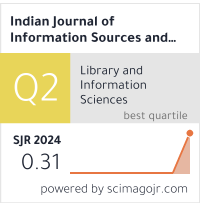Indian Research Trends in Fashion Technology: A Study Based on Scopus Database
DOI:
https://doi.org/10.51983/ijiss.2014.4.1.394Keywords:
Scientometrics, Fashion Technology, RGR and Doubling TimeAbstract
The paper portrays the results of a bibliometric analysis of Indian research publications in the field of fashion
technology research during the period 1970-2013. It analyses 2,864 articles of Scopus database in the field of Fashion technology. It examines year wise distribution of articles, country wise distribution, languages distribution and bibliographic form of articles, doubling time, relative growth rate, high productive Institutes etc. inferences and findings are shown with relevant data analysis.
References
Borner, K. (2010). Atlas of science: Vsualizing what we know. Cambridge: The MIT Press.
Borner, K., Chen, C. M. and Boyack, K. (2003). Visualizing knowledge domains. In B. Cronin (Ed.), Annual review of information science & technology (Chap. 5, Vol. 37, pp. 179– 255). Medford, NJ: Information Today, Inc./American Society for Information Science and Technology.
Beck, I. M. (1984). A method of measurement of scientific production. Science of Science, 4, 183–195.
Borner, K., Dall’Asta, L., Ke, W., and Vespignani, A. (2005). Studying the emerging global brain: Analyzing and visualizing the impact of co-authorship teams. Complexity, 10, 57–67.
Potter, W. G. (1988). Of making many books there is no end: Bibliometrics and libraries. The Journal of Academic Librarianship, 14, 238a–238c.
van Raan, A. F. J. (1996). Advanced bibliometric methods as quantitative core of peer review based evaluation and foresight exercises. Scientometrics, 36(3), 397–420.
Egghe, L., and Rousseau, R. (1990). Introduction to informetrics quantitative methods in library, documentation and information science. Amsterdam: Elsevier.
Egghe, L., and Rousseau, R. (2012). The Hirsch index of a shifted Lotka function and its relation with the impact factor. Journal of the American Society for Information Science and Technology, 63(5), 1048–1053.
Bruckner, E., Ebeling, W., and Scharnhorst, A. (1990). The application of evolution models in scientometrics. Scientometrics, 18, 21–41.
Glanzel, W. (2003). Bibliometric as a research field: A course on theory and application of bibliometric indicators. Course Handouts. http://nsdl.niscair.res.in.
Chung, K. H., and Cox, R. A. K. (1990). Patterns of productivity in the finance literature: A study of the bibliometric distributions. Journal of Finance, 45, 301–309.
Kealey, T. (2000). More is less. Economists and governments lag decades behind Derek Price’s thinking.Nature, 405, 279.
Vitanov, K., and Ausloos, M. (2012). Knowledge epidemics and population dynamics models for describing idea diffusion. In A. Scharnhorst, K. Borner, and P. van den Besselaar (Eds.), Models of science dynamics: Encounters between complexity theory and information sciences (Chap. 3, pp. 69–125). Berlin: Springer.
Ausloos, M. (2013). A Scientometrics law about co-authors and their ranking: the co-author core. Scientometrics, 95, 895-909.
CAGR,http://en.wikipedia.org/wiki/Compound_annual_growth_ rate (09.12.2013).
Downloads
Published
How to Cite
Issue
Section
License
Copyright (c) 2014 The Research Publication

This work is licensed under a Creative Commons Attribution-NonCommercial-NoDerivatives 4.0 International License.









